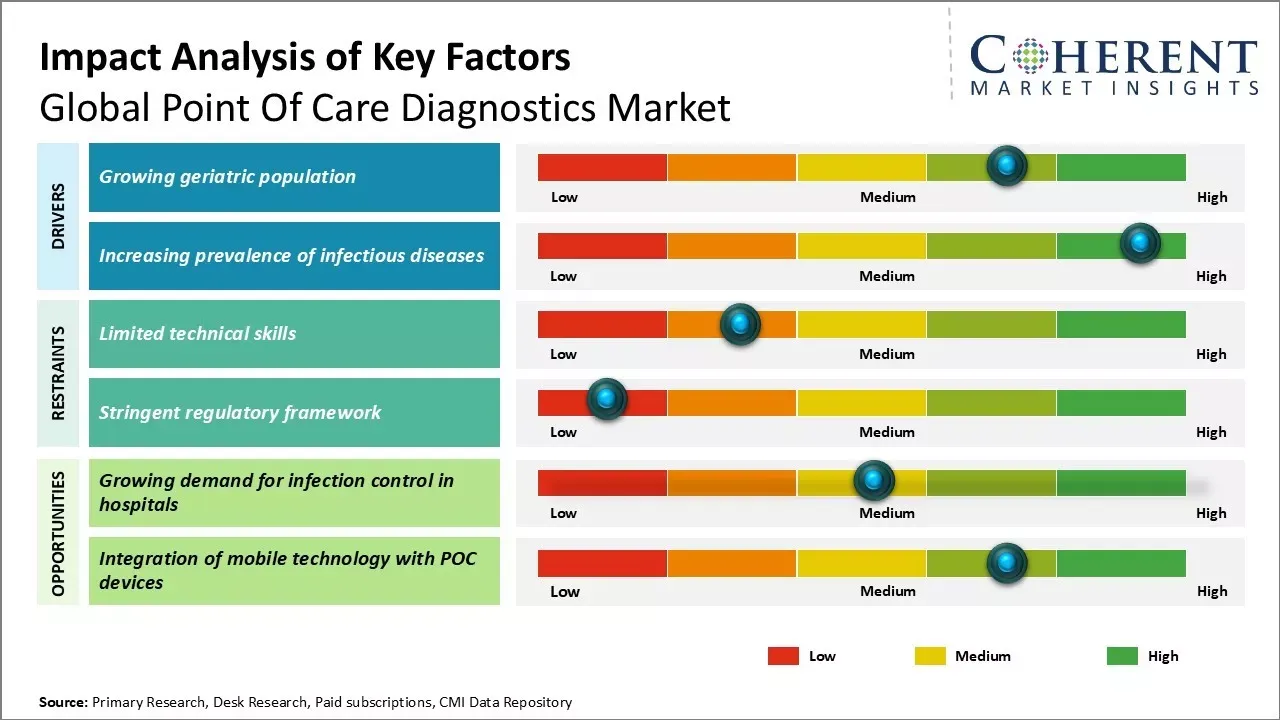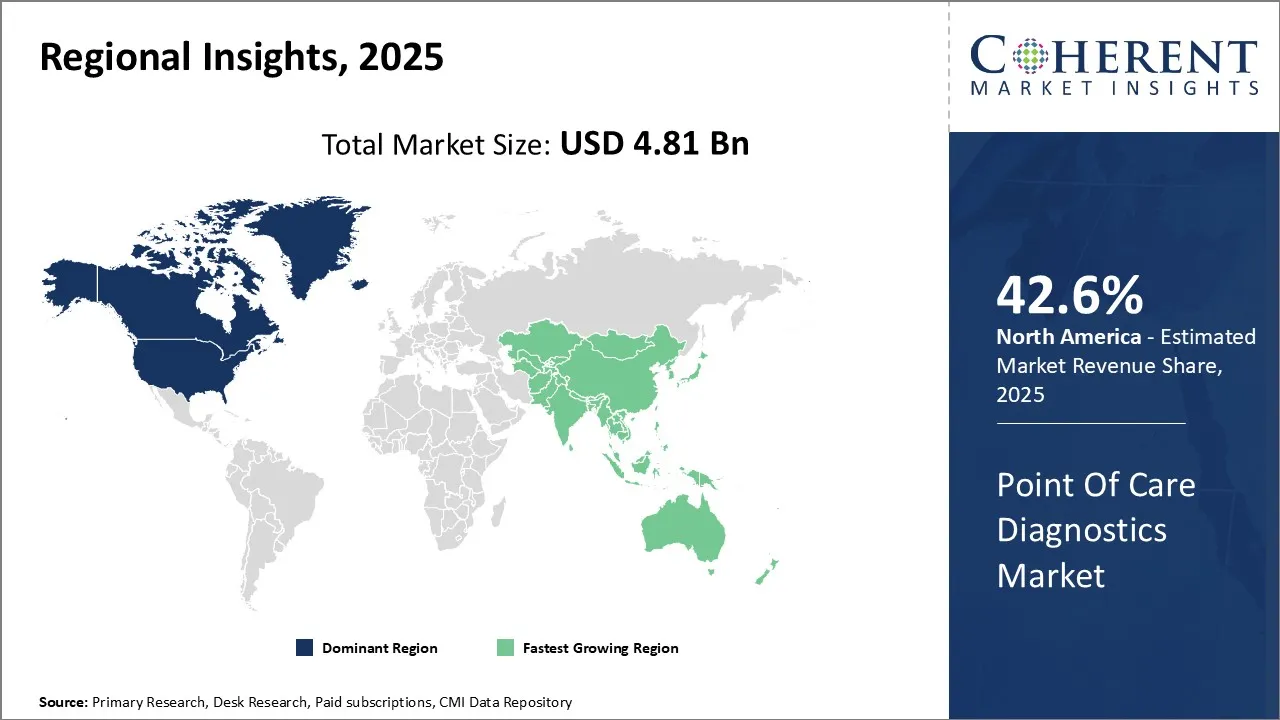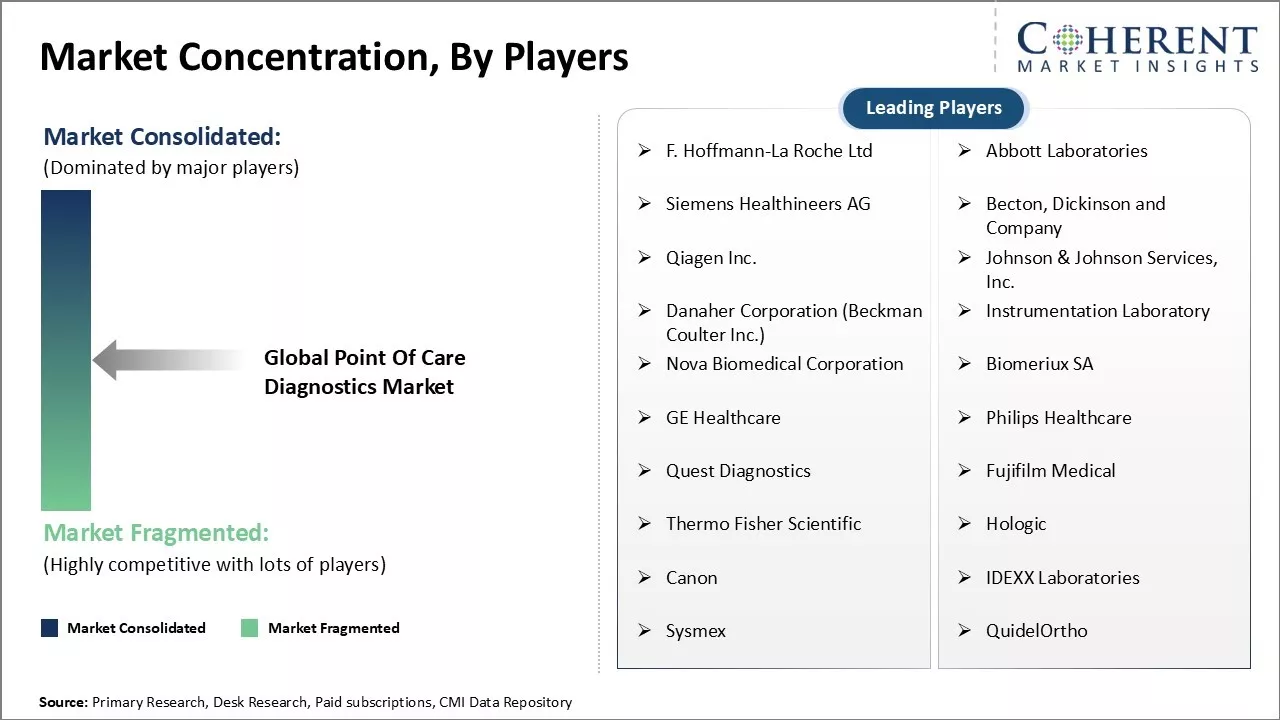Global point of care diagnostics market is estimated to be valued at USD 4.81 Bn in 2025 and is expected to reach USD 7.43 Bn by 2032, exhibiting a compound annual growth rate (CAGR) of 6.4% from 2025 to 2032.

To learn more about this report, Download Free Sample
The Point of Care Diagnostics Market is witnessing strong momentum due to rising demand for fast, decentralized testing solutions. Growing prevalence of infectious and chronic diseases, coupled with technological innovations and increased adoption in home and remote care settings, are driving point of care diagnostics market demand across global healthcare systems.
|
Current Events |
Description and its Impact |
|
Regulatory and compliance transformation |
|
|
Antimicrobial resistance crisis and diagnostic gaps |
|
Uncover macros and micros vetted on 75+ parameters: Get instant access to report
Artificial Intelligence is transforming Point of Care Diagnostics by enabling faster, more accurate, and accessible testing. AI algorithms integrated into portable devices can analyze complex data instantly, aiding in early detection of diseases like infections, cancer, and diabetes. These tools reduce reliance on centralized labs and skilled personnel, making diagnostics more efficient in rural, emergency, and home-care settings.
For instance, in October 2025, BD (Becton, Dickinson and Company) introduced new AI-enabled solutions aimed at enhancing connectivity across healthcare settings. These innovations support point-of-care diagnostics by integrating smart technologies that streamline data sharing, improve diagnostic accuracy, and enable faster clinical decision-making.
In terms of technology, lateral flow segment is estimated to contribute the highest market share of 40.5% in 2025, owing to its easy portability and ability to provide quick results. Lateral flow assays are extremely popular for point-of-care testing as these simply require an analyte sample to be added to a sample pad, from where it migrates along the test strip via capillary action. Interaction with colored particles generates a visible signal within minutes, allowing for rapid diagnosis without the need for complex instrumentation. This makes lateral flow highly convenient for applications such as home pregnancy tests and blood glucose monitoring. Its user-friendly design has boosted uptake in non-clinical settings as well as resource-limited areas. Lateral flow technology witness huge demand from the infectious disease testing segment since it enables swift analysis of samples in field conditions or at the point-of-care.
For instance, in July 2025, Volition unveiled a groundbreaking lateral flow test for point-of-care quantification of nucleosomes, marking a major advancement in diagnostic technology. This innovative test enables rapid, on-site detection of nucleosome biomarkers, which are linked to various diseases including cancer. Designed for ease of use and speed, it supports decentralized healthcare and enhances early disease diagnosis.
In terms of application, the infectious disease testing segment is estimated to contribute the highest market share in 2025. The global focus on controlling outbreaks such as influenza, HIV, and malaria has driven demand for rapid and accurate diagnostics. Point-of-care solutions enable early detection and timely intervention, especially in resource-limited settings. Governments and healthcare providers are increasingly investing in decentralized testing infrastructure, making infectious disease testing a cornerstone of public health strategies.
For instance, in January 2024, QIAGEN launched its new QIAstat-Dx syndromic testing panels in India, aimed at delivering rapid and accurate diagnosis of infectious diseases. These point-of-care tests offer multiplex detection of pathogens within approximately one hour, supporting timely clinical decisions. The initiative enhances diagnostic capabilities across hospitals and labs, especially in resource-limited and high-demand healthcare settings.
In terms of end user, hospitals segment is estimated to contribute the highest market share of 41.5% in 2025, owing to rising hospital-based outpatient and emergency care facilities. There has been notable shift towards ambulatory and decentralized healthcare models to relieve burden on tertiary care centers. This has led to higher installation of diagnostic labs, drive-through testing units, and clinical access points within hospital premises. On-site availability of near-patient testing aids fast clinical decision-making and streamlines treatment pathways especially for infectious emergencies, obstetrics & critical care cases. It also plays a key role in antimicrobial stewardship approaches by facilitating rapid pathogen identification. This drives hospitals to incorporate more POC diagnostic technologies for improved outreach as well as quality and efficiency of services.
For instance, in June 2025, Philips launched the Flash 5100 POC, a next-generation point-of-care ultrasound system designed for hospital use. Featuring advanced imaging capabilities and AI-driven tools, it enables rapid diagnostics at the bedside. The system supports emergency, critical care, and outpatient settings, enhancing clinical efficiency and decision-making in fast-paced healthcare environments.

To learn more about this report, Download Free Sample
North America dominates the global point of care diagnostics market with an estimated market share of 42.6% in 2025. With the presence of major players like Abbott, BD, Roche and several startups, the U.S. accounts for over 45.5% of the entire market. The region enjoys various advantages such as an expanding geriatric population prone to chronic diseases, widespread adoption of decentralized healthcare models, and favorable reimbursement policies promoting home-based testing. North America has a highly developed pharmaceutical industry contributing to continued innovation in technologies and products. Due to supportive regulatory environment under the U.S. FDA, medical devices and diagnostic kits face faster clearance pathway, ensuring companies recover R&D investments swiftly.
For instance, in July 2025, Phase Scientific launched the FebriDx test in the U.S., expanding its Indicaid respiratory portfolio with a novel point-of-care diagnostic tool. FebriDx rapidly differentiates between bacterial and viral respiratory infections using a simple fingerstick blood sample, delivering results in about 10 minutes. This innovation supports faster clinical decisions in outpatient and urgent care settings.
Asia Pacific has emerged as the fastest growing market for point of care testing diagnostics. Countries like China, India, Japan and South Korea are industrializing healthcare at an unprecedented rate. Favorable policies around medical tourism and public-private investments have accelerated infrastructure growth. China has invested for strengthening primary care delivery outside major hospitals. This emphasis on community-level testing coupled with rising affluence has boosted demand. Regional frontrunners like Sansure Biotech from China are expanding globally through acquisitions and partnerships. These offer low-cost alternatives to Western competitors. Growing prevalence of non-communicable diseases can also drive the market growth. Due to its massive population and government momentum around universal health coverage, Asia Pacific is primed to overtake other regions in the long run.
For instance, India’s Technology Development Board (TDB) is backing Primary HealthTech, a startup from IIT Guwahati, to advance its AI-powered Mobilab blood testing device. Designed for point-of-care use, Mobilab offers rapid, portable diagnostics, especially for rural and underserved areas. The innovation aims to enhance early disease detection and bridge healthcare access gaps across India.
The U.S. Point of Care Diagnostics market is growing due to rising infectious disease cases, demand for faster testing, and increased healthcare accessibility. Technological advancements, government and private funding, and a shift toward decentralized care are driving adoption. Portable diagnostic tools enable rapid results in hospitals, clinics, and home settings, improving early detection and treatment outcomes.
For instance, in February 2025, Avitia's launch of an AI-powered platform for rapid cancer testing is designed specifically for point-of-care use. The platform enables fast, accurate cancer diagnostics outside traditional lab settings, supporting early detection and clinical decision-making in outpatient, emergency, and resource-limited environments. This aligns with the growing trend of decentralized healthcare solutions.
India’s Point of Care Diagnostics market is growing due to rising chronic and infectious diseases, expanding rural healthcare access, and demand for rapid testing. Government initiatives, private investments, and technological innovations like AI-powered portable devices are driving adoption. These tools enable faster diagnosis and treatment, especially in underserved and semi-urban regions.
For instance, in April 2025, Hipro Biotechnology Co., Ltd., in collaboration with Affimedix, launched its SimplyRead™ IVD reagents and AUTO POCT-Lab Analyzers in India. The event in Mumbai marked Hipro’s entry into the Indian point-of-care diagnostics market, aiming to enhance rapid testing capabilities and expand access to decentralized healthcare solutions across the country.
| Report Coverage | Details | ||
|---|---|---|---|
| Base Year: | 2024 | Market Size in 2025: | USD 4.81 Bn |
| Historical Data for: | 2020 To 2024 | Forecast Period: | 2025 To 2032 |
| Forecast Period 2025 to 2032 CAGR: | 6.4% | 2032 Value Projection: | USD 7.43 Bn |
| Geographies covered: |
|
||
| Segments covered: |
|
||
| Companies covered: |
F. Hoffmann-La Roche Ltd, Abbott Laboratories, Siemens Healthineers AG, Becton, Dickinson and Company, Qiagen Inc., Johnson & Johnson Services, Inc., Danaher Corporation (Beckman Coulter Inc.), Instrumentation Laboratory, Nova Biomedical Corporation, Biomeriux SA, GE Healthcare, Philips Healthcare, Quest Diagnostics, Fujifilm Medical, Thermo Fisher Scientific, Hologic, Canon, IDEXX Laboratories, Sysmex, QuidelOrtho |
||
| Growth Drivers: |
|
||
| Restraints & Challenges: |
|
||
Uncover macros and micros vetted on 75+ parameters: Get instant access to report
The growing geriatric population is a key driver of the expanding Point of Care Diagnostics Market size. As aging individuals are more prone to chronic conditions such as diabetes, cardiovascular diseases, and respiratory disorders, there is a rising need for rapid, accessible diagnostic solutions. Point-of-care devices enable timely detection and monitoring of these conditions, reducing hospital visits and improving patient outcomes. Elderly patients benefit from the convenience and speed of near-patient testing, especially in home care and long-term care settings. This demographic shift is significantly influencing healthcare delivery models, fueling demand and contributing to the overall growth of the Point of Care Diagnostics Market size.

To learn more about this report, Download Free Sample
The increasing prevalence of infectious diseases such as tuberculosis, and influenza is significantly boosting the point of care diagnostics market share. These diseases demand rapid, accurate, and accessible testing to enable timely treatment and containment. Point-of-care diagnostic tools provide immediate results at or near the site of patient care, reducing the burden on centralized laboratories. Their portability and ease of use make them ideal for outbreak response, especially in remote or resource-limited settings. As global health systems prioritize early detection and real-time monitoring, the demand for point-of-care solutions continues to rise, driving substantial growth in market share.
The global Point of Care Diagnostics Market is witnessing significant opportunities, driven by rising demand for infection control and prevention in healthcare facilities. Rapid, near-patient testing enables timely diagnosis and treatment of hospital-acquired infections (HAIs), reducing clinical and economic burdens. Adoption of POC tests helps monitor antibiotic resistance and supports prompt treatment, curbing antimicrobial resistance. Decentralized testing lowers transmission risks and facility costs, while digital integration enhances infection surveillance. These advancements are fueling increased uptake of POC technologies, with the point of care diagnostics market forecast indicating continued growth as hospitals prioritize efficient infection management and real-time diagnostic capabilities
The Point-of-Care (POC) Diagnostics market is shifting from simple lateral-flow assays toward compact molecular platforms that deliver lab-quality results in minutes. This transition is reshaping competition—where cartridge-based molecular systems such as Abbott’s ID NOW and Cepheid’s GeneXpert dominate high-value clinical settings, while low-cost rapid tests compete on scale and distribution. The expansion of CLIA-waived testing sites, particularly pharmacies and primary care clinics, has increased accessibility but also intensified reimbursement and regulatory challenges.
The market now rewards vendors that can prove clinical and operational impact—reduced hospital stays, faster therapeutic decisions, or antimicrobial stewardship—rather than mere analytical accuracy. Connectivity has become a critical differentiator; health systems increasingly demand EHR integration, remote quality control, and secure data interoperability. Manufacturers lacking robust digital capabilities risk procurement exclusion.
Emerging markets present strong opportunities for rugged, battery-operated, and affordable molecular solutions, provided supply-chain and regulatory localization are addressed. Overall, commercial success in this sector depends on strategic clarity: high-margin molecular portfolios for clinical environments, differentiated reimbursement strategies, and rigorous evidence generation. The market is consolidating, and sustainable growth will favor companies that link diagnostic accuracy with measurable patient and system outcomes rather than pure test throughput.
Definition: Global point of care diagnostics market refers to medical diagnostic testing done at or near the site of patient care. This allows for rapid diagnosis and treatment decisions during the patient visit. Products in this market include blood glucose monitoring kits, pregnancy and fertility tests, influenza tests, drug-of-abuse tests, and HIV testing kits. The goal is to deliver faster results compared to standard lab tests, enabling timely clinical actions and improved health outcomes.
Share
Share
About Author
Manisha Vibhute is a consultant with over 5 years of experience in market research and consulting. With a strong understanding of market dynamics, Manisha assists clients in developing effective market access strategies. She helps medical device companies navigate pricing, reimbursement, and regulatory pathways to ensure successful product launches.
Missing comfort of reading report in your local language? Find your preferred language :
Transform your Strategy with Exclusive Trending Reports :
Frequently Asked Questions
Joining thousands of companies around the world committed to making the Excellent Business Solutions.
View All Our Clients